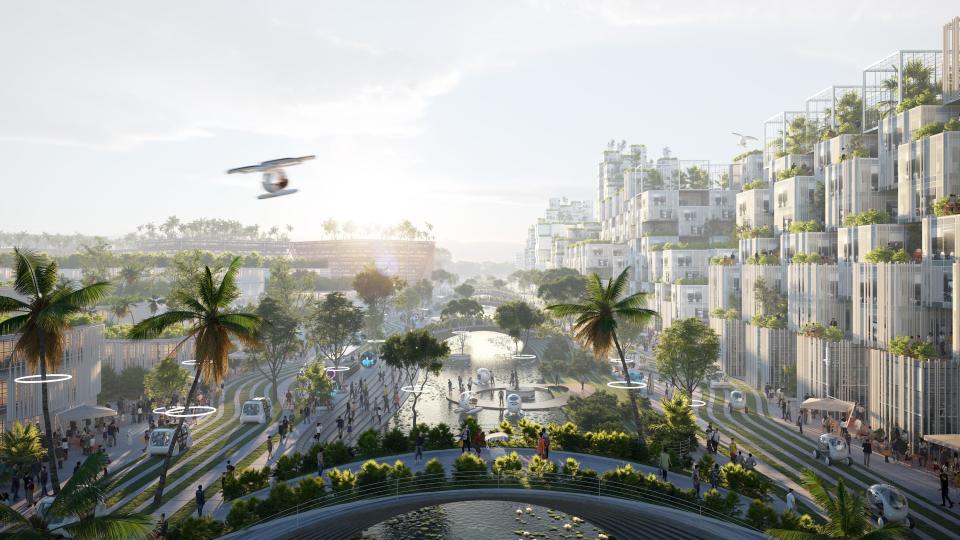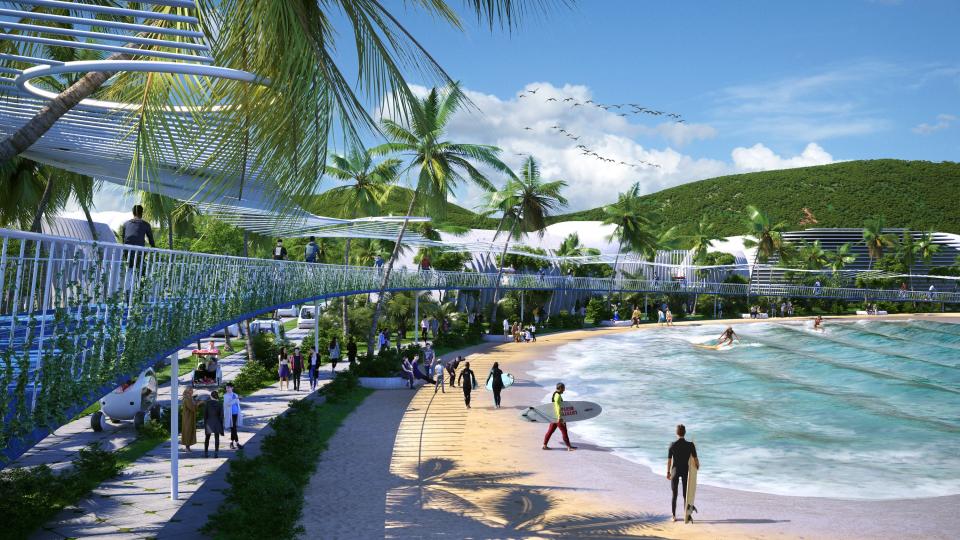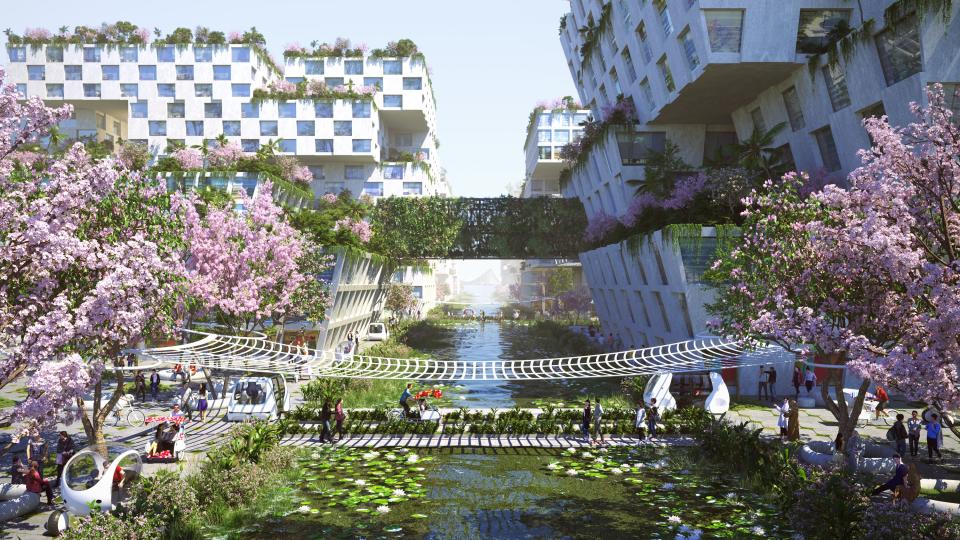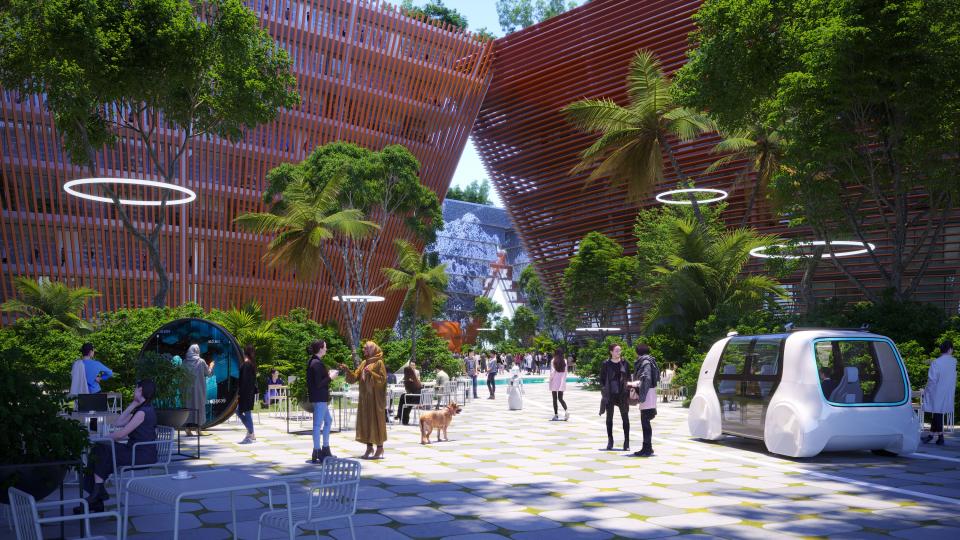How Bjarke Ingels Group Will Redesign Malaysian Islands for an Eco-Friendly Future
Toss at the Bjarke Ingels Group (BIG) just about any project—at any scale and any program—and the AD100 firm will inject it with its particular brand of future-forward panache, be it an energy-producing trash incinerator topped by a ski slope, a strategy to protect Manhattan’s coastline, or a driverless smart city. Last month, BIG (which has offices in Copenhagen, New York, London, and Barcelona) was awarded one of its most ambitious projects yet, one that will convert a swathe of mudflats in the Malaysian state of Penang into a constellation of artificial islands. The concept—dubbed “BiodiverCity” by the design team—will provide the framework for a resilient mixed-use development comprising business districts, cultural venues, recreational areas, and autonomous transportation networks, plus housing for some 400,000 residents and habitats for even more native plants and animals.
“[W]e are literally embarking on a journey to create more of Malaysia for future generations,” said firm founder Bjarke Ingels in a statement. “We have decided to set the bar as high as humanly possible by imagining a new archipelago that aims to be both more culturally and biologically diverse than previous developments.”

The new aqueous city will be located at the south edge of Penang Island, a turtle-shaped land mass that forms one half of the coastal state. Over the past few years, the island has become a leader in the technology sector, especially in the production of semiconductors and other electronic components. To accommodate future population growth and to fulfill economic goals set out in a strategic plan called Penang 2030, the state’s government launched an international design competition that called for the construction of three new islands near an existing airport. BIG, along with its local architect partner Hijjas and engineering firm Ramboll, plus a squadron of economic and environmental consultants, beat out 124 different proposals, including shortlisted entries from Foster + Partners and MVRDV.
When the BIG design team first began conducting site visits, they were struck by Malaysia’s rich cultural mix (a former British colony, Penang is home to people of Malay, Indian, and Chinese heritage, as well as a substantial British expat community. There was also a stunning tropical rainforest ecosystem that supports animals including sea turtles, monkeys, and egrets, as well as lush thickets of palms and mangroves. The mudflats where the archipelago is to be built are a popular launch spot for local fishermen but had been degraded by both fishing and polluted runoff. The design team wanted to ensure that the region’s rich cultural heritage and natural beauty would be preserved and celebrated. “We wanted to resist the potential generic-ness of any development and really wanted [our project] to accommodate all the richness that is there to begin with,” explains Jeremy Alain Siegel, an associate in BIG’s New York office.
To emulate and facilitate Penang Island’s “mosaic” of traditions, as Siegel puts it, the designers devised a petal-like scheme for each of the three artificial landmasses, each made up of a network of smaller islands radiating from a central body of water. By constructing plenty of shoreline (there will be at least 15 miles of accessible waterfront), the city can accommodate habitats for sea life (the design team includes both turtle and fish experts), provide a resilient buffer against sea level rise, and generate opportunities for water sports and transportation. “Our plan has all of these nooks and crannies on the edges in order to create a complex coastline, and then create different levels of water depth, as well as creating sheltered areas in the heart of each island,” Siegel explains.

Each “petal” ranges in size from 50 to 500 acres and accommodates about 15,000 people each in mixed-use districts. The first and easternmost island will host a 500-acre technology and research park, the second will support the city’s business and event centers, while the third will focus on housing built around a central marina. Each island will also be anchored by a landmark building, such as a performing arts center, museums, and a mosque, and will be peppered with amenities such as food markets, cultural spaces, and recreation areas, including a new fishing pier.
Though it’s still to be determined what specific buildings BIG might design, the team set up a series of architectural guidelines, informed by the traditions of Penang. Many of the region’s typical buildings, says Siegel, are “super-adapted to this climate, so we will be looking to learn from and build upon that.” Traditional shophouses in nearby George Town, for instance, used by merchants in the 19th century, feature peaked roofs that enable passive ventilation and shed rainwater. The structures also cantilever over the street, providing protected arcades for passersby. In renderings, the BIG team imagines similar buildings lining the canals, allowing pedestrians to move freely through the streets regardless of weather conditions.

Resiliency was, of course, a top priority for the plan, something BIG is well equipped to address, having proposed the “Big U,” a durable master plan for New York in the wake of Hurricane Sandy, as well as a floating city concept unveiled in 2019 that addresses sea level rise. The future island cluster is relatively sheltered from tsunamis, thanks to a surrounding cove, but the effects of climate change are a real risk; rising oceans are expected to inundate coastal cities by 2050 if left unchecked, especially in the Asia-Pacific region. So the designers incorporated a generous band of coastline that can be raised over time (in lieu of seawalls or barriers). “Our approach to all resiliency issues is not about punishing ourselves but by getting a win-win where we create a more desirable public realm,” says Siegel. The design team took into consideration habitats, too, and created sloped, shallow areas so that ecosystems and resident wildlife would be allowed to migrate.
The goal of a carbon-free future also permeates the archipelago’s design. The master plan calls for the city to be net-positive, meaning that the islands will generate more electricity than they use via solar panels and other renewable energy sources. The buildings themselves will rely on low-carbon materials such as bamboo, Malaysian wood species, and green concrete made from recycled materials. Even the landmasses and street grids themselves are designed with passive principles in mind, oriented toward the prevailing winds to naturally cool each district.

BiodiverCity’s goals may be ambitious, but the Penang state government, which has partnered with a local developer, is eagerly moving the project ahead; land reclamation is expected to begin for the first island next year. One of the biggest challenges will be devising a sustainable method to build the landmasses themselves. Traditional types of land reclamation, such as dredging and redepositing sand, are inherently invasive processes. In the coming phases of the project, the design team hopes to minimize the archipelago’s footprint and will be exploring other methods, such as elevating structures on stilts, or even floating some portions. Other hurdles—as with any development—could be political. Though the project is being run through the state of Penang, Malaysia’s federal government has been left grappling with the fallout from an ongoing scandal, a sweeping money-laundering scheme that hit former prime minister Najib Razak with a 12-year prison sentence this summer.
Despite the challenges, the project will mark a radical proof-of-concept for sustainable development. And as the world continues to battle COVID-19—and consider a future where pandemics are the norm— concepts pioneered in urban environments like the BiodiverCity (walkability and quality open space chief among them) could provide a way forward. What’s more, Siegel points out, with remote work becoming increasingly prevalent, people can begin to choose how and where they want to live. “For me, [the best feature of the project] is to have a city that is infused with water. Think about what a special place Venice is, or Amsterdam is, and how few cities are like that in the world,” says Siegel. “We're really looking to create something like that here.”
Originally Appeared on Architectural Digest

